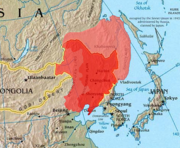
Back Прыамур’е Byelorussian Manchouria Diavaez Breton Vnější Mandžusko Czech Äußere Mandschurei German Manchuria Exterior Spanish Amuurimaa Estonian Kanpoko Mantxuria Basque Mandchourie-Extérieure French Manchuria Luar ID Manciuria Esterna Italian
Outer Manchuria
Russian Manchuria | |
|---|---|
 Outer Manchuria, north and east of the China-Russia border, shown in light red. | |
| Country | |
| Federal subjects | |
| Named for | Manchuria |
| Area | |
| • Total | 910,000 km2 (350,000 sq mi) |
| Demonym | Manchu |
| History of Manchuria |
|---|
 |

Outer Manchuria,[3][4][1][2][5] sometimes called Russian Manchuria, refers to a region in Northeast Asia that is now part of the Russian Far East[1] but historically formed part of Manchuria (until the mid-19th century). While Manchuria now more normatively refers to Northeast China, it originally included areas consisting of Priamurye between the left bank of Amur River and the Stanovoy Range to the north, and Primorskaya which covered the area in the right bank of both Ussuri River and the lower Amur River to the Pacific Coast. The region was ruled by a series of Chinese dynasties and the Mongol Empire, but control of the area was ceded to the Russian Empire by the Qing China during the Amur Annexation in the 1858 Treaty of Aigun and 1860 Treaty of Peking,[6] with the terms "Outer Manchuria" and "Russian Manchuria" arising after the Russian annexation. The same general area became known as Green Ukraine after a large number of settlers from Ukraine came to the region.
- ^ a b c Schneider, Julia C. (2017). "The New Setting: Political Thinking after 1912". Nation and Ethnicity: Chinese Discourses on History,. p. 277. ISBN 978-90-04-33011-5. ISSN 1574-4493. OCLC 974211957. "In the mid-19th century, the Qing government gave over (so-called) Outer Manchuria, where mostly non-Manchu Tungusic people dwelled, to the Russian Empire by the Treaty of Aigun (Aigun tiaoyue, 1858) and the (First) Convention of Peking (Beijing tiaoyue, 1860)....The Convention of Peking, one of several unequal treaties, moreover assigned the parts in the East of the Ussuri River (Wusulijiang) to Russia. Outer Manchuria, also called Russian Manchuria was never claimed to be part of a Chinese nation-state. Today it belongs to the Russian Federation, is no longer referred to as Outer Manchuria, and is considered to be part of Siberia. Consequently, the name Manchuria refers only to Inner Manchuria today. In the following, I will refer to Inner Manchuria as Manchuria."
- ^ a b Kissinger, Henry (2011). "From Preeminence to Decline". On China. New York: Penguin Press. p. 68. ISBN 978-1-59420-271-1. LCCN 2011009265. OCLC 1025648355. "For these services Moscow exacted a staggering territorial price: a broad swath of territory in so-called Outer Manchuria along the Pacific coast, including the port city now called Vladivostok.¹⁴ In a stroke, Russia had gained a major new naval base, a foothold in the Sea of Japan, and 350,000 square miles of territory once considered Chinese."
- ^ Shurtleff, William (2022). History of Soybeans and Soyfoods in Manchuria (1833-2022). Soyinfo Center. p. 6. ISBN 9781948436670.
- ^ Shi, David (2023). Spirit Voices: The Mysteries and Magic of North Asian Shamanism. Red Wheel Weiser. p. 140. ISBN 9781633412835.
- ^ Bolton, John (April 12, 2023). "A New American Grand Strategy to Counter Russia and China". The Wall Street Journal. ISSN 0099-9660. OCLC 781541372. Archived from the original on 29 April 2023."New Russian leaders may or may not look to the West rather than Beijing, and might be so weak that the Russian Federation’s fragmentation, especially east of the Urals, isn’t inconceivable. Beijing is undoubtedly eyeing this vast territory, which potentially contains incalculable mineral wealth. Significant portions of this region were under Chinese sovereignty until the 1860 Treaty of Peking transferred “outer Manchuria,” including extensive Pacific coast lands, to Moscow."
- ^ O'Hanlon, Michael E. (2015). "Conflicts Real, Latent, and Imaginable". The Future of Land Warfare. Washington, D.C.: Brookings Institution Press. p. 55. ISBN 978-081572689-0. OCLC 930512519.
© MMXXIII Rich X Search. We shall prevail. All rights reserved. Rich X Search